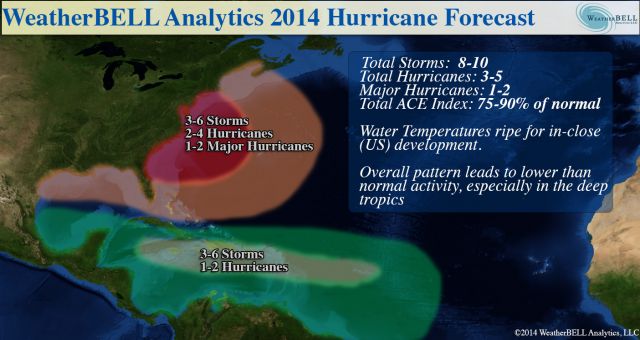2014 Hurricane Season Forecast 11 years ago
April 8, 2014

Commentary
In summary:
Named Storms: 8-10
Hurricanes: 3-5
Major Hurricanes: 1-2
ACE: 75-90% of normal
The deep tropics (south of 22.5°N) will have less to much-less than normal activity this year. Farther north, the very warm water off of the Eastern Seaboard is a concern, along with the oncoming El Niño conditions. There have been plenty of El Niño years with high impact seasons for the U.S. coast: 1957, 1965, 1969, 1976, 1983 (fading but still there), 1991, 1992, 2002, and 2004 are examples. The pattern favors stronger storms (relative to normals) in-close to the U.S. rather than in the deep tropics.
The ECMWF model is in strong agreement with this. Last year, it actually rang a warning bell with its forecast for near normal activity (it also did in 2012, but wasn't too accurate that year). This year, the ECMWF March tropical forecast is lower than those years.
What is different is that the ECMWF model has a forecast for higher than average activity near the East Coast of the U.S.! We have been in awe at the lack of activity near the East Coast over the last 20 years, given the similar cycle to the 1950s. While Irene and Sandy have drawn significant attention, they were nothing compared to the meteorological mayhem of the 1950s or the intensity of 1938 and 1944. There is nothing to prohibit another Sandy-type hit from the southeast or three storms up the East Coast in one year despite a relatively low number of named storms in a season. The benchmark year on the eastern seaboard, 1954, had well below normal tropical activity in the deep tropics, with only Hazel being a strong storm south of 20°N, so there is strong historical support for the ECMWF's idea.
The combination of dry air, what looks to be a relatively colder AMO index, a poor setup for the Indian Ocean wave train, and the oncoming El Niño all argue against higher than normal frequency in the deep tropics. We think this a challenging year, one that has a greater threat of higher intensity storms closer to the coast, and, where like 2012, warnings will frequently be issued with the first official NHC advisory.